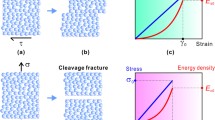Abstract
Materials failure under some sort of loading is a well-known natural phenomenon, and the reliable prediction of materials failure is the most important key issue for many different kinds of engineering structures based on their safety considerations. In this research, instead of establishing empirical models, the material failure process was modeled as a nonequilibrium process based on the microstructural mechanism. Then, the evolution equations were established and the stability analysis was carried out to obtain the critical conditions for the materials failure. It was found that the material strength was a global property in nature, and the commonly used local criteria based on the most dangerous point failure were not the rational assumption. Based on the idea, some examples were considered, such as the size effect of the material strength, the strength of the polycrystalline metals, the stress-strain relationship of the ultrafine crystalline metal with nanoscale growth twins, the strength of lithium niobite crystal specimens with notches. All of the theoretical predictions gave reasonable results compared with the experimental data.
Similar content being viewed by others
References
A. A. Griffith, Phil. Trans. R. Soc. Lond. A 221, 163 (1921).
K. Lu, L. Lu, and S. Suresh, Science 324, 349 (2009).
R. H. Telling, C. J. Pickard, M. C. Payne, and J. E. Field, Phys. Rev. Lett. 84, 5160 (2000).
D. Kondepudi, and I. Prigogine, Modern Thermodynamics: From Heat Engines to Dissipative Structures (John Wiley & Sons, Chichester, 2014).
Z. P. Bažant, Archive Appl. Mech. (Ingenieur Archiv) 69, 703 (1999).
A. Taloni, M. Vodret, G. Costantini, and S. Zapperi, Nat. Rev. Mater. 3, 211 (2018).
B. Sun, Dimensinal Analysis and Lie Group (in Chinese) (China High Education Press, Beijing, 2016).
Z. P. Bažant, I. M. Daniel, and Z. Li, J. Eng. Mater. Tech. 118, 317 (1996).
C. C. Vu, J. Weiss, O. Plé, D. Amitrano, and D. Vandembroucq, J. Mech. Phys. Solids 121, 47 (2018).
P. B. Zdeněk, and M. T. Kazemi, J. Am. Cream. Soc. 73, 1841 (1990).
S. Bandis, A. C. Lumsden, and N. R. Barton, Int. J. Rock Mech. Min. Sci. GeoMech. Abstracts 18, 1 (1981).
B. Wang, and J. P. Boehler, J. Mech. Phys. Solids 44, 2103 (1996).
T. Mura, Micromechanics of Defects in Solids (Kluwer Academic Publisher, Dordrecht, Boston, London, 1987).
C. Unger, and W. Klein, Phys. Rev. B 29, 2698 (1984).
L. Lu, X. Chen, X. Huang, and K. Lu, Science 323, 607 (2009).
Z. Cheng, H. Zhou, Q. Lu, H. Gao, and L. Lu, Science 362, 6414 (2018).
X. Li, Y. Wei, L. Lu, K. Lu, and H. Gao, Nature 464, 877 (2010).
M. Dao, L. Lu, Y. F. Shen, and S. Suresh, Acta Mater. 54, 5421 (2006).
B. Clausen, T. Lorentzen, and T. Leffers, Acta Mater. 46, 3087 (1998).
R. A. Masumura, P. M. Hazzledine, and C. S. Pande, Acta Mater. 46, 4527 (1998).
M. Liu, Y. Gan, D. A. H. Hanaor, B. Liu, and C. Chen, Eng. Fract. Mech. 149, 134 (2015).
G. R. Irwin, ASME J. Appl. Mech. 24, 109 (1957).
J. Chen, B. Wang, and Y. Hu, J. Mech. Phys. Solids 107, 451 (2017), arXiv: 1610.01467.
J. P. Chen, and B. Wang, Sci. China-Phys. Mech. Astron. 62, 954611 (2019).
W. Yang, H. T. Wang, T. F. Li, and S. X. Qu, Sci. China-Phys. Mech. Astron. 62, 014601 (2019).
R. F. Zhang, C. L. Ren, J. W. Feng, and Y. Q. Ma, Sci. China-Phys. Mech. Astron. 62, 117012 (2019), arXiv: 1903.06387.
K. M. Liew, Z. Pan, and L. W. Zhang, Sci. China-Phys. Mech. Astron. 63, 234601 (2020).
Y. Sun, K. Y. Zeng, and T. Li, Sci. China-Phys. Mech. Astron. 63, 278701 (2020).
Z. Wu, S. Huang, J. Ding, W. Wang, and X. Luo, Sci. China-Phys. Mech. Astron. 61, 114712 (2018).
F. Berto, and P. Lazzarin, Mat. Sci. Eng. R 75, 1 (2014).
C. C. Yang, and Y.-W. Mai, Mat. Sci. Eng. R 79, 1 (2014).
Author information
Authors and Affiliations
Corresponding author
Additional information
This work was supported by the National Natural Science Foundation of China (Grant Nos. 11832019, 11472313, and 13572355). Dr. JiaPeng Chen, my former PhD student, and now my post-doctoral associate helped me to carry out the detail calculation shown in Figure 5, and help me to draw the Figures 6 and 9, and Mr. Jun Hui, my PhD student, helped me to collect the data and draw the Figures 1–4. The author appreciated their help very much.
Rights and permissions
About this article
Cite this article
Wang, B. The intrinsic nature of materials failure and the global non-equilibrium energy criterion. Sci. China Phys. Mech. Astron. 63, 124611 (2020). https://doi.org/10.1007/s11433-020-1610-8
Received:
Accepted:
Published:
DOI: https://doi.org/10.1007/s11433-020-1610-8




